Chapter 2 - Light - Exercises and MCQ Exercise 112
Question 1

Solution 1
(a)
(v) less than one focal length
Ans1(b)
(iii) inverted and magnified.
Ans1(c)
(E) (i), (ii) and (iii)
Ans1(d)
(D) (ii) and (iii) only
Ans1(e)
(ii) real
Ans1(f)
(ii) virtual, erect, diminished
Ans1(g)
(v) Both the images are real and inverted.
(v) less than one focal length
Ans1(b)
(iii) inverted and magnified.
Ans1(c)
(E) (i), (ii) and (iii)
Ans1(d)
(D) (ii) and (iii) only
Ans1(e)
(ii) real
Ans1(f)
(ii) virtual, erect, diminished
Ans1(g)
(v) Both the images are real and inverted.
Chapter 2 - Light - Exercises and MCQ Exercise 113
Question 1
A pin 2 cm long is placed 12 cm away from a convex lens at right angles to the principal axis. If the focal length of the lens is 20 cm, by scale drawing find the size of the image and its magnification.
Solution 1
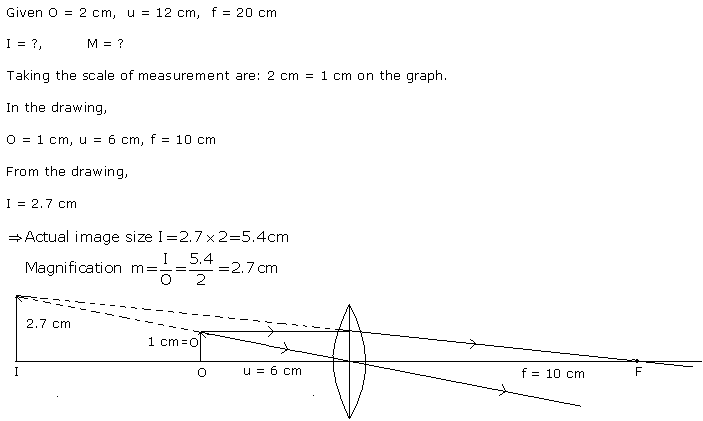
Question 2
(a) Define the term 'focus' of a lens.
(b) Distinguish between concave and convex lens.
(b) Distinguish between concave and convex lens.
Solution 2
(a) Principal focus: Rays of light can pass through the lens in any direction and hence there will be two principal foci on either side of the lens and they are referred to as the first principal focus and the second principal focus of a lens.
First Principal Focus (F1)
It is a point on the principal axis of the lens such that the rays of light starting from it (convex lens) or appearing to meet at the point (concave lens) after refraction from the two surfaces of the lens become parallel to the principal axis of the lens.
Second Principal Focus (F2)
It is a point on the principal axis of the lens such that the rays of light parallel to the principal axis of the lens after refraction from both the surfaces of the lens pass through this point (convex lens) or appear to be coming from this point.
(b)

First Principal Focus (F1)
It is a point on the principal axis of the lens such that the rays of light starting from it (convex lens) or appearing to meet at the point (concave lens) after refraction from the two surfaces of the lens become parallel to the principal axis of the lens.
Second Principal Focus (F2)
It is a point on the principal axis of the lens such that the rays of light parallel to the principal axis of the lens after refraction from both the surfaces of the lens pass through this point (convex lens) or appear to be coming from this point.
(b)

Question 3
(a) Draw a sketch to show how a lens is able to produce an image of the sun on a paper screen.
(b)(i) Would you regard the rays from the sun as being divergent, parallel or convergent?
(ii) What is the name given to the point where such rays meet after they have passed through the lens?
(iii) How does the image of the sun sometimes burn a paper screen?
(b)(i) Would you regard the rays from the sun as being divergent, parallel or convergent?
(ii) What is the name given to the point where such rays meet after they have passed through the lens?
(iii) How does the image of the sun sometimes burn a paper screen?
Solution 3
(a)
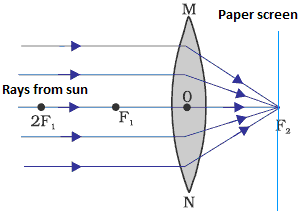
(b)
(i) Rays from sun can be regarded as parallel rays.
(ii) The point is called 'Focus'.
(iii) A convex lens is used to focus the sun rays on a piece of paper to burn a piece of paper. A large amount of heat gets concentrated at a point and is sufficient to burn the piece of paper.

(b)
(i) Rays from sun can be regarded as parallel rays.
(ii) The point is called 'Focus'.
(iii) A convex lens is used to focus the sun rays on a piece of paper to burn a piece of paper. A large amount of heat gets concentrated at a point and is sufficient to burn the piece of paper.
Question 4
(a) What type of a lens can be used as a magnifying glass?
(b) Show by a ray diagram the formation of a real image by simple magnifying lens.
(b) Show by a ray diagram the formation of a real image by simple magnifying lens.
Solution 4
(a) A convex lens with short focal length can be used as a magnifying glass.
(b) A simple magnifying glass forma a virtual, erect and magnified image of a tiny object which is distinctly seen by the eye because the eye lens converges the rays to form a real image on the retina.
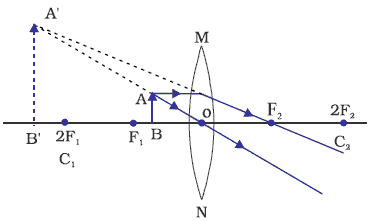
Ray diagram for the formation of image by a magnifying glass.
(b) A simple magnifying glass forma a virtual, erect and magnified image of a tiny object which is distinctly seen by the eye because the eye lens converges the rays to form a real image on the retina.

Ray diagram for the formation of image by a magnifying glass.
Chapter 2 - Light - Exercises and MCQ Exercise 114
Question 1
In the following diagram (Fig. 6), the object and the image formed by the respective lenses are shown. Complete the ray diagram, and locate the focus. Find the focal length of the lens.

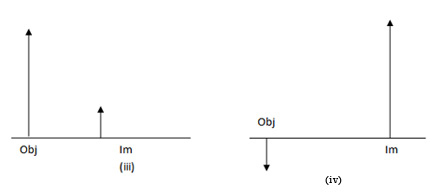


Solution 1
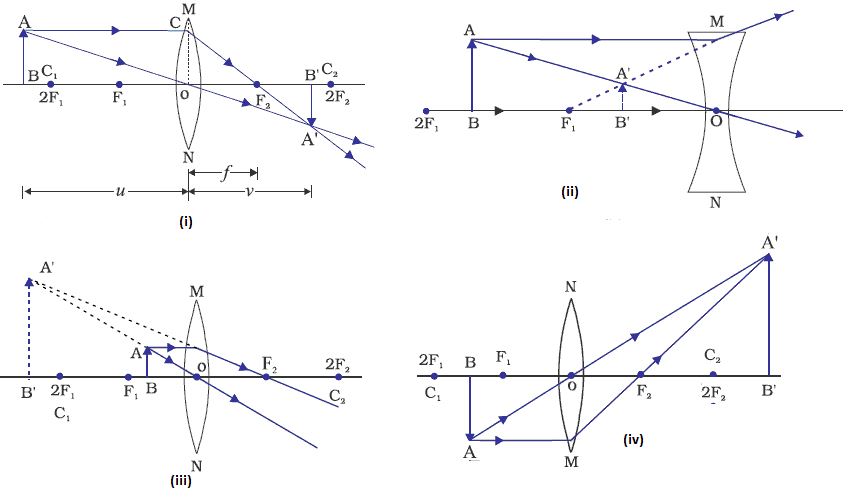
Question 2
Ray diagram for the formation of image by a magnifying glass.
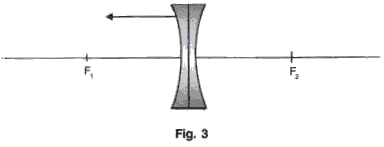

Solution 2
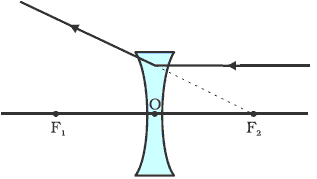
Question 3
(a) What is meant by the power of accommodation produced?
(b) How is accommodation produced?
(c) What type of lenses are used in spectacles worn by an old lady for knitting?
(b) How is accommodation produced?
(c) What type of lenses are used in spectacles worn by an old lady for knitting?
Solution 3
(a) The image of the objects at different distances from the eye is brought to focus on the retina by changing the focal length of the eye lens. This is called the power of accommodation of the eye.
(b) Accommodation is achieved with the help of ciliary muscles.
To focus the distant objects, the ciliary muscles are relaxed causing the eye lens to become thin and thus increasing the focal length of the eye lens.
To form the image of a near object on the retina, the ciliary muscles contract and thereby pull the ends of the choroid closer. Thus, the eye lens thickens to shorten its focal length and converges the rays to form the image.
In this manner, by changing the focal length of the eye lens, the image of the objects at different distances is brought to focus on the retina.
(c) A converging lens of suitable focal length is used in the spectacles worn by an old lady for knitting.
(b) Accommodation is achieved with the help of ciliary muscles.
To focus the distant objects, the ciliary muscles are relaxed causing the eye lens to become thin and thus increasing the focal length of the eye lens.
To form the image of a near object on the retina, the ciliary muscles contract and thereby pull the ends of the choroid closer. Thus, the eye lens thickens to shorten its focal length and converges the rays to form the image.
In this manner, by changing the focal length of the eye lens, the image of the objects at different distances is brought to focus on the retina.
(c) A converging lens of suitable focal length is used in the spectacles worn by an old lady for knitting.
Question 4
An object AB is placed in front of a convex lens as shown in fig. 4. Complete the ray diagram and obtain the image formed and state the nature of the image.


Solution 4
Nature of image: Real, inverted and magnified.
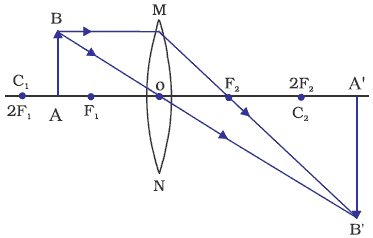

Question 5
An object is placed in front of a converging lens and in front of a diverging lens as in fig. 5.

(a)Complete the ray diagram to obtain an image.
(b)Compare the nature of image formed by both the lenses in the above case.

(a)Complete the ray diagram to obtain an image.
(b)Compare the nature of image formed by both the lenses in the above case.
Solution 5
(a)
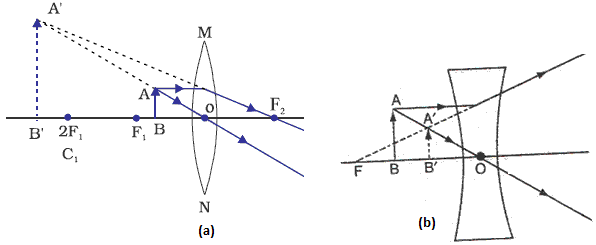
(b) In both the cases the image formed is virtual, upright and on the same side of the lens but the image formed by a convex lens is magnified and that formed by a concave lens is diminished.

(b) In both the cases the image formed is virtual, upright and on the same side of the lens but the image formed by a convex lens is magnified and that formed by a concave lens is diminished.
Chapter 2 - Light - Exercises and MCQ Exercise 115
Question 1
The above table shows different parts of the electromagnetic spectrum.
(a) Identify the parts of the spectrum marked as A, B, C and D.
(b) Which of the radiations A or B has the higher frequency?
(c) State two properties which are common to all parts of the electromagnetic spectrum.
(d) Name one source of each of the radiation of electromagnetic spectrum.
(e) Name one detector for each of the radiation.
(f) Name one use of each of the radiation.
Solution 1
(a) A, B, C and D are microwaves, infrared waves, ultraviolet light and x-rays respectively.
(b) Radiations B (microwaves) have a higher frequency.
(c) Common properties of e-m spectrum:
(i) All electromagnetic waves travel with the same speed in vacuum (or air) which is equal to the speed of light i.e. 3 x 108 m/s.
(ii) These waves are unaffected by the electric and magnetic fields.
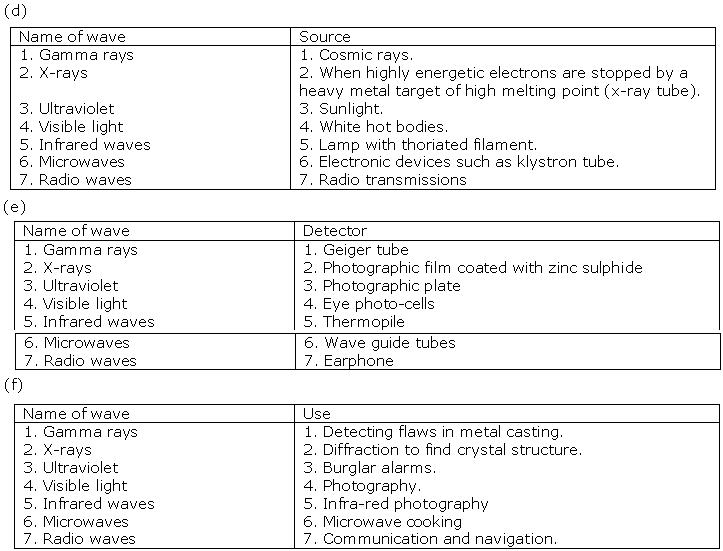
(b) Radiations B (microwaves) have a higher frequency.
(c) Common properties of e-m spectrum:
(i) All electromagnetic waves travel with the same speed in vacuum (or air) which is equal to the speed of light i.e. 3 x 108 m/s.
(ii) These waves are unaffected by the electric and magnetic fields.

Question 2
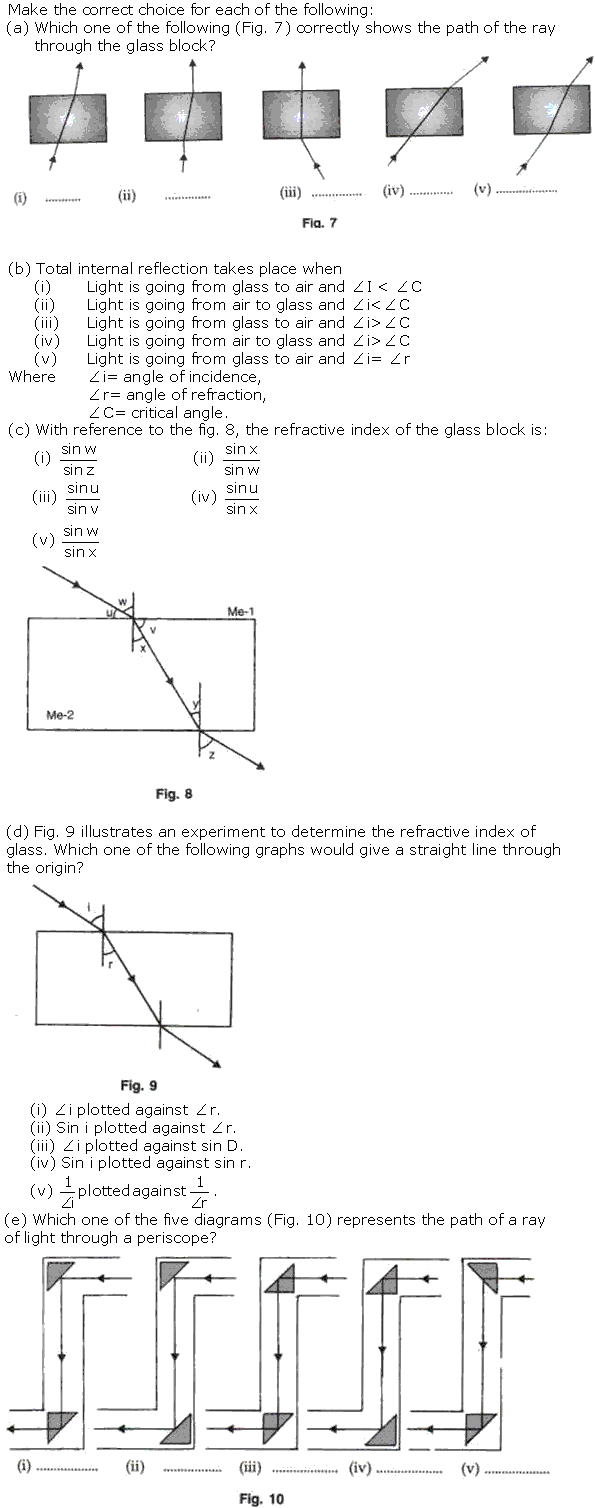
Solution 2
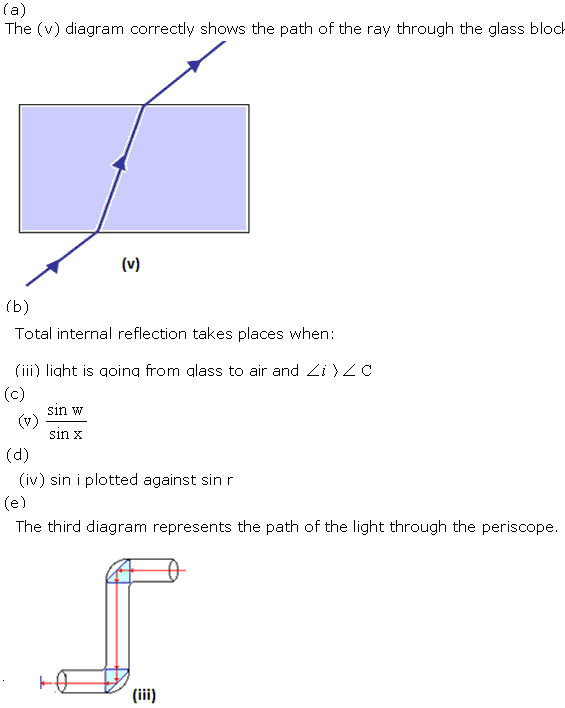
Chapter 2 - Light - Exercises and MCQ Exercise 116
Question 1
Fig. 11 shows two rays of light Op and OQ coming from an object at the bottom of a pond, incident on the water surface.
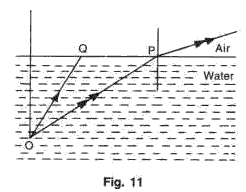
(a) Mark on the diagram
(i) The angle of incidence of ray OP,
(ii) The angle of refraction of ray Op,
(iii) The position of image of the object as seen from above.
(iv) An approximate path of the ray OQ.
(b) Explain, why do the rays of light change directions on passing from water to air.
(c) A fish in water sees everything outside the water by rays of light entering its eye in a small cone of light. Draw a diagram and explain how does this happen.

(a) Mark on the diagram
(i) The angle of incidence of ray OP,
(ii) The angle of refraction of ray Op,
(iii) The position of image of the object as seen from above.
(iv) An approximate path of the ray OQ.
(b) Explain, why do the rays of light change directions on passing from water to air.
(c) A fish in water sees everything outside the water by rays of light entering its eye in a small cone of light. Draw a diagram and explain how does this happen.
Solution 1
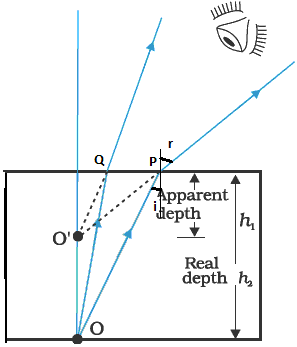
(i) Angle of incidence (i) of ray OP is marked in the above diagram.
(ii) Angle of refraction (r) of ray OP is marked in the above diagram.
(iii) The position of image of the object (O') as seen from above is marked in the diagram.
(iv) An approximate path of ray OQ is shown in the above diagram.
(b) Water is a denser medium as compared to air; so on passing from water (denser) to air (rarer) the speed of light of light increases and it bends away from the normal.
(c)
Refraction is the bending of light as it passes from a medium of one optical density into a medium of a different optical density, as from air to water or water into air. The amount of bending is dependent upon the incident angle of the light. In the diagram below, a light ray, "A" strikes the water at right angles and passes through the surface without bending. But as the incident angle decreases (becomes less than 90 degrees) the light bends more and morerays "B" and "C." Light striking the surface parallel to the surface, bends downward.
Since light is coming into the water from all directions, refraction creates a cone of light with its base on the surface and its apex at the fish's eye. The base of the cone is a circular opening at the surface through which the fish sees the entire outside world. This opening is called the "Fish's Window". Only the light passing through the window enters the fish's eye. Notice line "D," It's a ray entering the water beyond the window; refraction bends it such that it cannot reach the fish's eye.

Question 2
(a)A ray of light is incident at 450 on the face of
(i) A rectangular block of glass.
(ii) A 600 glass prism.
(b) Draw a sketch showing how the ray of monochromatic ray of light passes through glass in each case.
(c) With the aid of a diagram, explain how the face of a right angled prism may totally reflect incident on it.
(d) A thick plane mirror produces several faint images in addition to a prominent one. Draw a ray diagram showing how reflection and refraction produce all these images.
(e) Fig. 12 represents a stone S at the bottom of a pond of water. Using the two rays, as shown, complete the ray diagram to show where the image of the stone appears when viewed from E.
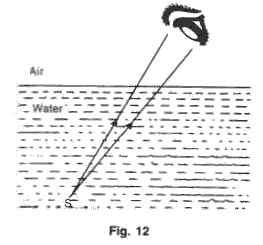
(f) What is a''mirage'? Explain with the help of a diagram.
(g) A man observes the bottom of a swimming pool of 3 m depth. If the refractive index of water is 1.3, what is the apparent depth of water?
(h) When a ray of light undergoes refraction through a glass slab and when it emerges it is displaced laterally (Fig. 13). What are the factors on which the lateral displacement depends?
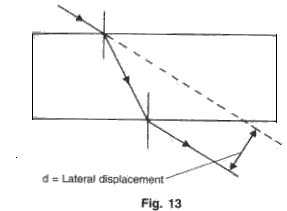
(i) Fig. 14 shows three rays of light OA, OB and OC passing from water to air, making angles 490, 410 and 350 with the horizontal surface respectively. Draw an approximate path of the emergent ray for each. (Critical angle of water is 490.)
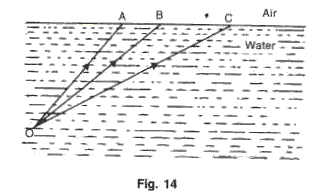
(i) A rectangular block of glass.
(ii) A 600 glass prism.
(b) Draw a sketch showing how the ray of monochromatic ray of light passes through glass in each case.
(c) With the aid of a diagram, explain how the face of a right angled prism may totally reflect incident on it.
(d) A thick plane mirror produces several faint images in addition to a prominent one. Draw a ray diagram showing how reflection and refraction produce all these images.
(e) Fig. 12 represents a stone S at the bottom of a pond of water. Using the two rays, as shown, complete the ray diagram to show where the image of the stone appears when viewed from E.

(f) What is a''mirage'? Explain with the help of a diagram.
(g) A man observes the bottom of a swimming pool of 3 m depth. If the refractive index of water is 1.3, what is the apparent depth of water?
(h) When a ray of light undergoes refraction through a glass slab and when it emerges it is displaced laterally (Fig. 13). What are the factors on which the lateral displacement depends?

(i) Fig. 14 shows three rays of light OA, OB and OC passing from water to air, making angles 490, 410 and 350 with the horizontal surface respectively. Draw an approximate path of the emergent ray for each. (Critical angle of water is 490.)

Solution 2

Chapter 2 - Light - Exercises and MCQ Exercise 117
Question 1
Define critical angle and explain total internal reflection. What are the conditions necessary for total internal reflection?
Solution 1
Critical angle: The angle of incidence in the denser medium for which the angle of refraction in the rarer medium is 90o.
Total internal reflection: It is an optical phenomenon that occurs when a ray of light strikes the boundary of denser medium at an angle greater than the critical angle w.r.t. the normal of the surface; this ray is then totally reflected back into the denser medium.
The two necessary conditions for total internal reflection to take place are:
1.The light ray must proceed from denser to rarer medium.
2. Angle of incidence in denser medium should be greater than the critical angle for the pair of media in contact.
Total internal reflection: It is an optical phenomenon that occurs when a ray of light strikes the boundary of denser medium at an angle greater than the critical angle w.r.t. the normal of the surface; this ray is then totally reflected back into the denser medium.
The two necessary conditions for total internal reflection to take place are:
1.The light ray must proceed from denser to rarer medium.
2. Angle of incidence in denser medium should be greater than the critical angle for the pair of media in contact.
Question 2
(a) A ray of monochromatic light enters glass PQRS as shown in the fig. 15. Complete the path of ray till it emerges from the glass. (Critical angle of glass is 420).
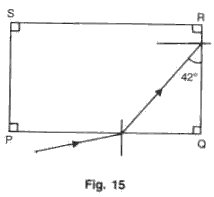
(b) Draw diagram of a prism periscope.
(c) What are the advantages of total internal reflecting prism over plane mirror?

(b) Draw diagram of a prism periscope.
(c) What are the advantages of total internal reflecting prism over plane mirror?
Solution 2

Question 3
Fig. 16 shows a ray of white light that passes through a prism and produces a spectrum.
(a) Name the phenomenon that is taking place.
(b) What colour would you see at X and Y?
(c) What radiation would you detect above X and below Y?
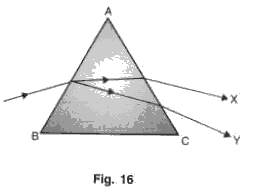
(a) Name the phenomenon that is taking place.
(b) What colour would you see at X and Y?
(c) What radiation would you detect above X and below Y?

Solution 3
(a) Dispersion
(b) Red colour at X and violet colour at Y.
(c) Above X, we would detect infra-red radiation and below Y, ultra-violet radiation.
(b) Red colour at X and violet colour at Y.
(c) Above X, we would detect infra-red radiation and below Y, ultra-violet radiation.
Chapter 2 - Light - Exercises and MCQ Exercise 118
Question 1
Give two properties of ultraviolet radiations which differ from the visible light.
Solution 1
Two properties of ultraviolet radiation different from the visible light:
1. Ultraviolet radiation can pass through quartz, but they are absorbed by glass.
2. They are usually scattered by the dust particles present in the atmosphere.
1. Ultraviolet radiation can pass through quartz, but they are absorbed by glass.
2. They are usually scattered by the dust particles present in the atmosphere.
Question 2
Mention three properties of infra red radiations similar to the visible light. Give two such properties of infrared radiations which are not true for visible light.
Solution 2
Three properties of infrared radiations similar to the visible light:
1. They travel in straight lines as light does, with a speed equal to 3 x 108 m/s in vacuum.
2. They obey laws of reflection and refraction.
3. They are unaffected by electric and magnetic fields.
Two properties of infrared radiation different from the visible light:
1. They are absorbed by glass, but they are not absorbed by rock-salt.
2. They are detected by their heating property using a thermopile or a blackened bulb thermometer.
1. They travel in straight lines as light does, with a speed equal to 3 x 108 m/s in vacuum.
2. They obey laws of reflection and refraction.
3. They are unaffected by electric and magnetic fields.
Two properties of infrared radiation different from the visible light:
1. They are absorbed by glass, but they are not absorbed by rock-salt.
2. They are detected by their heating property using a thermopile or a blackened bulb thermometer.
Question 3

Solution 3
Waves A are Gamma radiations.
Waves B are infrared radiations.
In vacuum, both travel with the same speed. Hence, the ratio of their speeds is 1:1.
Waves B are infrared radiations.
In vacuum, both travel with the same speed. Hence, the ratio of their speeds is 1:1.
Chapter 2 - Light - Exercises and MCQ Exercise 119
Question 1
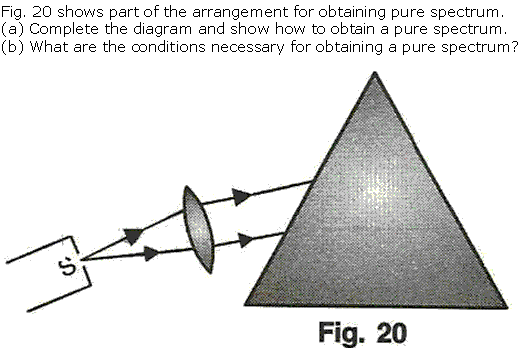
Solution 1
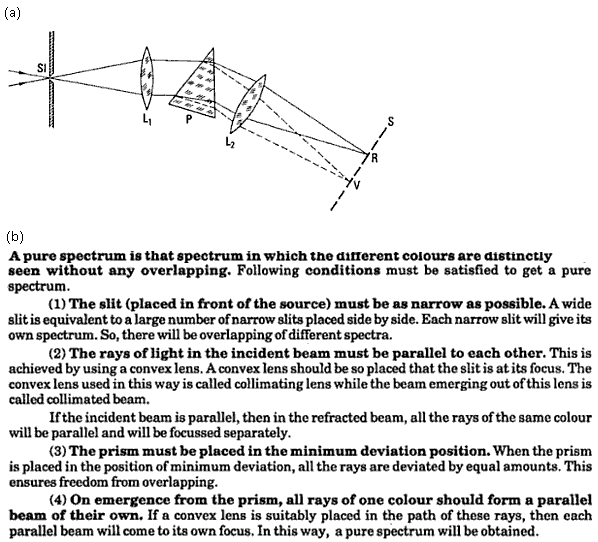
Question 2
What are ultraviolet radiations? How are they detected? State two properties and one use of ultraviolet radiations.
Solution 2
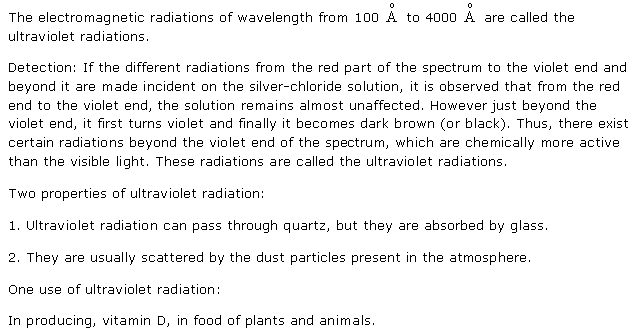
Question 3
Name three properties of ultraviolet radiations which are similar to visible light.
Solution 3
Three properties of ultraviolet radiations similar to the visible light:
1. They travel in straight lines as light does, with a speed equal to 3 x 108 m/s in vacuum.
2. They obey laws of reflection and refraction.
3. They are unaffected by electric and magnetic fields.
1. They travel in straight lines as light does, with a speed equal to 3 x 108 m/s in vacuum.
2. They obey laws of reflection and refraction.
3. They are unaffected by electric and magnetic fields.
Question 4
An electromagnetic wave has a frequency of 500 MHz and a wavelength of 60 cm. Calculate the velocity of the wave. Name the medium through which it is traveling.
Solution 4
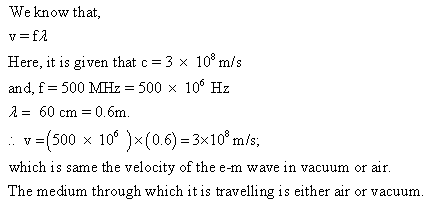

0 comments:
Post a Comment